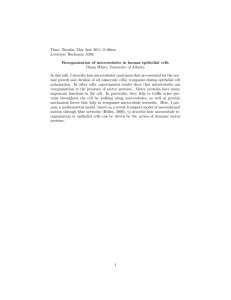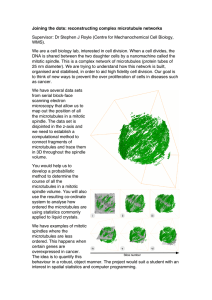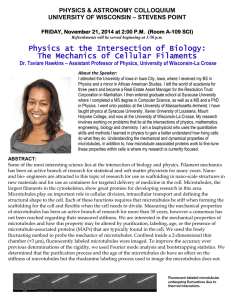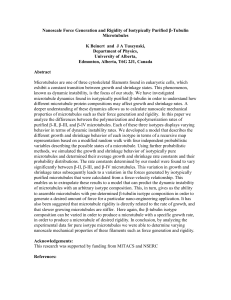The Unusual Microtubule Polarity in Teleost Retinal Pigment
advertisement
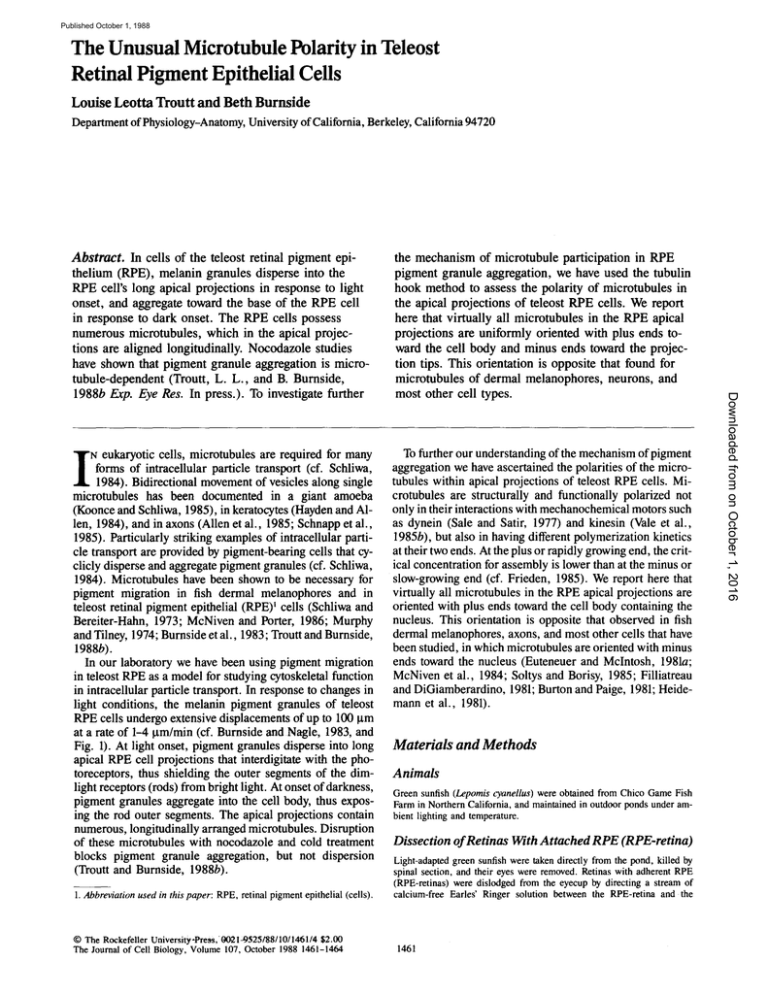
Published October 1, 1988 The Unusual Microtubule Polarity in Teleost Retinal Pigment Epithelial Cells Louise Leotta Troutt and Beth Burnside Department of Physiology-Anatomy, University of California, Berkeley, California 94720 the mechanism of microtubule participation in RPE thelium (RPE), melanin granules disperse into the RPE cell's long apical projections in response to light onset, and aggregate toward the base of the RPE cell in response to dark onset. The RPE cells possess numerous microtubules, which in the apical projections are aligned longitudinally. Nocodazole studies have shown that pigment granule aggregation is microtubule-dependent (Troutt, L. L., and B. Burnside, 1988b Exp. Eye Res. In press.). To investigate further pigment granule aggregation, we have used the tubulin hook method to assess the polarity of microtubules in the apical projections of teleost RPE cells. We report here that virtually all microtubules in the RPE apical projections are uniformly oriented with plus ends toward the cell body and minus ends toward the projection tips. This orientation is opposite that found for microtubules of dermal melanophores, neurons, and most other cell types. N eukaryotic cells, microtubules are required for many forms of intracellular particle transport (cf. Schliwa, 1984). Bidirectional movement of vesicles along single microtubules has been documented in a giant amoeba (Koonce and Schliwa, 1985), in keratocytes (Hayden and Allen, 1984), and in axons (Allen et al., 1985; Schnapp et al., 1985). Particularly striking examples of intracellular particle transport are provided by pigment-bearing cells that cyclicly disperse and aggregate pigment granules (cf. Schliwa, 1984). Microtubules have been shown to be necessary for pigment migration in fish dermal melanophores and in teleost retinal pigment epithelial (RPE) ~ cells (Schliwa and Bereiter-Hahn, 1973; McNiven and Porter, 1986; Murphy and Tilney, 1974; Burnside et al., 1983; Troutt and Burnside, 1988b). In our laboratory we have been using pigment migration in teleost RPE as a model for studying cytoskeletal function in intracellular particle transport. In response to changes in light conditions, the melanin pigment granules of teleost RPE cells undergo extensive displacements of up to 100 gm at a rate of 1-4 Ixm/min (cf. Burnside and Nagle, 1983, and Fig. 1). At light onset, pigment granules disperse into long apical RPE cell projections that interdigitate with the photoreceptors, thus shielding the outer segments of the dimlight receptors (rods) from bright light. At onset of darkness, pigment granules aggregate into the cell body, thus exposing the rod outer segments. The apical projections contain numerous, longitudinally arranged microtubules. Disruption of these microtubules with nocodazole and cold treatment blocks pigment granule aggregation, but not dispersion (Troutt and Burnside, 1988b). To further our understanding of the mechanism of pigment aggregation we have ascertained the polarities of the microtubules within apical projections of teleost RPE cells. Microtubules are structurally and functionally polarized not only in their interactions with mechanochemical motors such as dynein (Sale and Satir, 1977) and kinesin (Vale et al., 1985b), but also in having different polymerization kinetics at their two ends. At the plus or rapidly growing end, the critical concentration for assembly is lower than at the minus or slow-growing end (cf. Frieden, 1985). We report here that virtually all microtubules in the RPE apical projections are oriented with plus ends toward the cell body containing the nucleus. This orientation is opposite that observed in fish dermal melanophores, axons, and most other cells that have been studied, in which microtubules are oriented with minus ends toward the nucleus (Euteneuer and Mclntosh, 1981a; McNiven et al., 1984; Soltys and Borisy, 1985; Filliatreau and DiGiamberardino, 1981; Burton and Paige, 1981; Heidemann et al., 1981). I 1. Abbreviation used in this paper: RPE, retinal pigment epithelial (cells). Materials and Methods Animals Green sunfish (Lepomis cyanellus) were obtained from Chico Game Fish Farm in Northern California, and maintained in outdoor ponds under ambient lighting and temperature. Dissection of Retinas With Attached RPE (RPE-retina) Light-adapted green sunfish were taken directly from the pond, killed by spinal section, and their eyes were removed. Retinas with adherent RPE (RPE-retinas) were dislodged from the eyecup by directing a stream of calcium-free Earles' Ringer solution between the RPE-retina and the © The RockefellerUniversity-Preas,'OO21J9525188/lO/1461/4 $2.00 The Journal of Cell Biology, Volume 107, October 1988 1461-1464 1461 Downloaded from on October 1, 2016 Abstract. In cells of the teleost retinal pigment epi- Published October 1, 1988 Bruch'e Membram RPE Outer Limiting -Membrane Rod Cone Light Adapted Rod Cone Dark Adapted choroid. This ringer contained 5 mM EGTA, 1 mM MgSO4, 24 mM sodium bicarbonate, 25 mM glucose, 3 mM Hepes, 1 mM ascorbate, pH 7.4. The RPE-retina was freed from the eyecup by severing the optic nerve and then bisected along the choroid fissure. Microtubule Polarity Determination Microtubules in 2-ram squares of green sunfish RPE-retina were decorated as described previously with endogenous tubulin (Troutt and Burnside, 1988a), a procedure adapted from the well-documented methods for decorating microtubules with exogenous tubulin (Heidemann and McIntosh, 1980; Mclntosh and Euteneuer, 1984; Euteneuer and Mclntosh, 1981a, b). In this procedure no exogenous tubulin is added to the decoration medium. Briefly, tissue was incubated in a lysis and hook-assembly medium (l mM EGTA, I mM MgC12, 1 mM GTP, 2.5% DMSO, 1% Triton X-100, and 0.5% deoxycholate in 0.5 M Pipes buffer, pH 6.9) at 0°C for 30 min, 22°C for 10 min, then 37°C for 15 min. After treatment retinas were fixed and embedded for electron microscopy as previously described (Troutt and Burnside, 1988a). Blocks were oriented so that RPE apical projections were cross-sectioned. Microtubule orientation was ascertained as described by Heidemann and Mclntosh (1980) in micrographs of RPE projections in cross section, printed at 60,000x. Clockwise hooks indicate that the observer is looking toward the minus end (Mclntosh and Euteneuer, 1984). Microtubules were scored for clockwise or counterclockwise hooks, or as ambiguous if they bore hooks in both directions. Decorated microtubules with hooks that connected them to other microtubules or appearing as doublets were not scored to indicate polarity. Figure 2. Microtubule polarity shown by decoration with hooks of endogenous tubulin in cross sections of RPE projections of green sunfish. Sections are viewed toward the cell body. Hooks are counterclockwise, indicating that the microtubule plus ends are oriented toward the cell body. Arrowheads indicate some prominently decorated microtubules. (P) pigment granule. Bar, 0.2 ~tm. An average of 65.6 + 6.3% (n = 20 projections) of the microtubules in individual RPE projections were decorated with hooks from endogenous tubulin. RPE projections were identified by their possession of pigment granules. In 45 RPE projections, 205 decorated microtubules were scored for polarity orientation. When viewing the projection toward the cell body 92.7 % of decorated microtubules had one or more hooks in the counterclockwise direction (Fig. 2). This indicates that virtually all of the microtubules in the RPE projects are oriented with plus ends toward the cell body and minus ends toward the distal tip of the projection. Another 4.4% of scored microtubules had clockwise hooks, and 2.9% had hooks in both directions. Since this polarity of microtubules with minus ends distal to the cell body is highly unusual (Euteneuer and Mclntosh, 1981a; McNiven et al., 1984; Soltys and Borisy, 1985; Filliatreau and DiGiamberardino, 1981; Burton and Paige, 1981; Heidemann et al., 1981), it was confirmed by comparing microtubule polarity in RPE projections and in photorecep- The Journal of Cell Biology, Volume 107, 1988 1462 Results Microtubule Polarity Downloaded from on October 1, 2016 Figure 1. Retinomotor movements in the retina of lower vertebrates. In response to light onset, cones contract, rods elongate and pigment disperses into the apical projections of the RPE cell. In response to dark onset, cones elongate, rods contract, and pigment aggregates to the RPE cell body. Published October 1, 1988 tors within the same field of view. In these micrographs RPE microtubules bore counterclockwise hooks, indicating plus ends toward the cell body, while rod myoid microtubules had clockwise hooks, indicating plus ends toward the synaptic end of the cell, as previously shown (Troutt and Burnside, 1988a). After treatment of RPE cells with the described hook decoration procedures, the morphology of the apical projections closely resembled that of directly fixed material, and the average number of microtubules in a projection of a dispersed cell was 14 + 2 (n = 18 projections). This is comparable to the number of microtubules in projections after direct fixation of light-adapted sunfish RPE (Breunner and Burnside, 1986). Thus the decoration procedures did not produce a notable decrease in microtubule number within RPE projections compared with directly fixed tissue, and polarity was determined for a population of microtubules representative of those existing in vivo. Nonetheless the microtubules became decorated without the use of exogenous tubulin, implying that hooks were formed with tubulin derived from some endogenous pool as described for photoreceptors (Troutt and Burnside, 1988a). Discussion Troutt and Burnside An Unusual Polarity of Microtubules 1463 Downloaded from on October 1, 2016 Although it has become generally accepted that microtubules play necessary roles in various forms of intracellular particle transport (cf. Schliwa, 1984), the mechanisms of their participation in force production for movement are not fully understood. One view is that mechanochemical ATPase motors can associate with particles, and by cyclicly detaching and reattaching to a microtubule, move particles short distances along the microtubule surface with each cycle. At least two classes of microtubule-associated motors have been described: kinesin-like ATPases, which move along microtubules toward their plus ends (Vale et al., 1985a, b; Porter et al., 1987), and dynein-like ATPases, which move toward microtubule minus ends (Satir, 1968; Sale and Satir, 1977; Paschal and Vallee, 1987; Paschal et al., 1987). Thus, it is interesting to know the relative positions of the plus and minus ends of microtubules within RPE apical projections. The polarity would provide useful information about the constraints that must be met by putative motors responsible for particle transport. Virtually all microtubules within teleost RPE apical projections were shown by the decoration study to be oriented with plus ends toward the cell body (nucleus) and minus ends toward the distal tip of the projection. Microtubules are required for pigment granule aggregation (Troutt and Burnside, 1988b). Thus, microtubule-dependent pigment aggregation in RPE projections entails particle movement toward the cell body and thus toward microtubule plus ends, a polarity of movement characteristic of kinesin. The orientation of RPE microtubules could also have implications for the mechanism of phagosome transport in RPE cells. Phagosomes containing photoreceptor disk membranes are transported by a microtubule-dependent process from the apical projections to the cell body where they fuse with lysosomes (Herman and Steinberg, 1982). Uniform microtubule polarity may direct the unidirectional movement of phagosomes in an apical to basal direction. The direction of phagosome movement in RPE apical projections resem- bles pigment aggregation in being toward the cell body, i.e., toward microtubule plus ends. In both cases the direction of transport is characteristic of that mediated by a kinesin-like motor (Vale et al., 1985b). The present observations neither prove nor refute that a molecular motor is involved in microtubule-dependent pigment granule aggregation or phagosome transport in RPE cells, but indicate that if a microtubule-dependent motor is involved it must be a plus-end-directed molecule such as kinesin, and not a minus-end-directed molecule such as dynein. The microtubule polarity in RPE cells is opposite that reported in projections of dermal melanophores, in which microtubule plus ends are oriented distally (Euteneuer and Mclntosh, 1981a; McNiven et al., 1984). In melanophores, the direction of pigment granule migration in the cellular projections has been correlated with microtubule polarity (McNiven and Porter, 1986). RPE cells and melanophores differ also in the direction of pigment movement produced by treatments that elevate cyclic AMP. In teleost RPE, cyclic AMP induces pigment aggregation (Burnside and Basinger, 1983); whereas in dermal melanophores, cyclic AMP induces pigment dispersion (cf. Schliwa and Bereiter-Hahn, 1974). Thus in both cell types cyclic AMP induces pigment granule transport toward microtubule plus ends. The finding that microtubules of green sunfish RPE projections are unusually oriented with plus ends toward the nucleus of the cell contrasts with most previous findings and raises questions about the mechanism by which the RPE cell generates its microtubule array. Most cell types that have been examined have microtubules oriented with minus ends toward the nucleus (Heidemann et al., 1981; Euteneuer and Mclntosh, 1981a; Soltys and Borisy, 1985). In many cell types microtubule organizing centers (MTOCs) have been described, usually as perinuclear centrosomal regions from which microtubules emanate (cf. Brinkley, 1985). Such MTOCs have been shown to nucleate the formation of microtubule arrays (cf. Brinkley, 1985). In cases where MTOCassociated microtubules have been assayed for polarity, all microtubules were found to be oriented with minus ends toward the MTOC (Heidemann and Mclntosh, 1980; Mclntosh and Euteneuer, 1984; Telzer and Haimo, 1981; Euteneuer and Mclntosh, 1981a; McNiven et al., 1984). The polarity of microtubules in RPE projections would indicate that if they are associated with the perinuclear centrosome, they would have to be associated with it by their plus ends. However, there is no information at this time to suggest that the microtubules of RPE apical projections are in fact associated with the cell's perinuclear centrosome. The highly stable array of microtubules in RPE projections may resemble that described in another epithelial cell type, cultured canine kidney (MDCK) cells in which microtubules do not appear to be associated with a centrosome (Br6 et al., 1987). The high degree of order of RPE microtubules suggests that the cell does have some mechanism for dictating the polarity of projection microtubules. Br6 and coworkers (1987) suggest that in MDCK cells, stable microtubules are modified so that complete depolymerization does not occur and fragments of the microtubules then act as seeds for reassembly. Such a mechanism could perpetuate the polarity of microtubules in RPE projections but it would not explain how the orientation of the microtubule array is established initially. Published October 1, 1988 Summary The Journal of Cell Biology, Volume 107, 1988 1464 We have assessed the polarity of microtubules in the apical projections of teleost RPE cells, by decorating the microtubules with hooks of endogenous tubulin. Virtually all microtubules in the RPE projections are oriented with plus ends toward the cell body (nucleus). This orientation is such that a kinesin-like molecule could produce force for transport during microtubule-dependent pigment granule aggregation. Microtubule polarity in RPE cells is opposite that in dermal melanophores, where microtubules are oriented with plus ends distal. The direction of cAMP-induced migration is also opposite in these 2 cell types: in RPE, cAMP induces pigment aggregation, whereas in melanophores cAMP induces pigment dispersion. Thus in both cell types cAMP induces pigment migration toward microtubule plus ends. The authors would like to thank Dr. Kathryn Pagh-Roehl for critical reading of the manuscript. This work was supported by National Institutes of Health grant EY-03575 and National Science Foundation grant DCB-8608751. Received for publication 25 March 1988, and in revised form 10 June 1988. References Downloaded from on October 1, 2016 Allen, R. D., D. G. Weiss, J. H. Hayden, D. T. Brown, H. Fujiwake, and M. Simpson. 1985. Gliding movement of and bidirectional transport along single native microtubules from squid axoplasm: evidence for an active role of microtubules in cytoplasmic transport. J. Cell Biol. 100:1736-1752. Br~, M.-H., T. E. Kreis, and E. Karsenti. 1987. Control of microtubule nucleation and stability in Madin-Darby canine kidney cells: the occurrence of noncentrosomal, stable detyrnsinated microtubules. J. Cell Biol. 105:12831296. Brinkley, B. R. 1985. Microtubule organizing centers. Annu. Rev. Cell Biol. 1:145-172. Breunner, U., and B. Burnside. 1986. Pigment granule migration in isolated cells of the teleost retinal pigment epithelium. Invest. Ophthalmol. Vis. Sei. 27:1634-1643. Burnside, B., and S. Basinger. 1983. Retinomotor pigment migration in the teleost retinal pigment epithelium. II. Cyclic-3',5'-adenosine monophosphate induction of dark-adaptive movement in vitro. Invest. Ophthalmol. Vis. Sci. 24:16-23. Burnside, B., and B. W. Nagle. 1983. Retinomotor movements of photoreceptots and retinal pigment epithelium: mechanisms and regulation. In Progress in Retinal Research. Vol. 2. Osborne and Chader, editors. Pergamon Press, Oxford, New York. 67-109. Burnside, B., R. A. Adler, and P. O'Connor. 1983. Pigment migration in the teleost retinal pigment epithelium. I. Roles for actin and microtubules in pigment granule transport and cone movement. Invest. Ophthalmol. Vis. Sei. 24:1-15. Burton, P. R. 1985. Ultrastructure of the olfactory neuron of the bulffrog: the dendrite and its microtubules. J. Comp. Neurol. 242:147-160. Burton, P. R., and J. L. Paige. 1981. Polarity of axoplasmic microtubules in the olfactory nerve of the frog. Proc. Natl. Acad. Sci. USA. 78:3269-3273. Euteneuer, U., and J. R. Mclntosh. 1981a. Polarity of some motility-related microtubules. Proc. Natl. Aead. Sci. USA. 78:372-376. Euteneuer, U., and J. R. McIntosh. 1981b. Structural polarity of kinetochore microtubules in PtKI cells. J. Cell Biol. 89:338-345. Filliatreau, O., and L. DiGiamberardino. 1981. Microtubule polarity in myelinated axons as studied after decoration with tubulin. Biol. Cell. 42:69-72. Frieden, C. 1985. Aetin and tubulin polymerization: the use of kinetic methods to de~rmine mechanism. Annu. Rev. Biophys. Biophys. Chem. 14:189-210. Hayden, J. H., and R. D. Allen. 1984. Detection of single microtubules in living ceils: particle transport can occur in both directions along the same microtubule. J. Cell Biol. 99:1785-1793. Heidemann, S. R., and J. R. Mclntosh. 1980. Visualization of the structural polarity of microtubules. Nature. (Lond.). 286:517-519. Heidemann, S. R., J. M. Landers, and M. A. Harnborg. 1981. Polarity orientation of axonal microtubules. J. Cell Biol. 91:661-665. Herman, K. G., and R. H. Steinberg. 1982. Phagosome movement and the diurnal pattern of phagocytosis in the tapetal retinal pigment epithelium of the opposum. Invest. Ophthalmol. Vis. Sci. 23:277-290. Koonce, M. P., and M. Schliwa. 1985. Bidirectional organelle transport can occur in cell processes that contain single microtubules. J. Cell Biol. 100: 322-326. Mclntosh, J. R., and U. Euteneuer. 1984. Tubulin hooks as probes for microtubule polarity: An analysis of the method and an evaluation of data on microtubule polarity in the mitotic spindle. J. Cell Biol. 98:525-533. McNiven, M. A., and K. R. Porter. 1986. Microtubule polarity confers direction to pigment transport in chromatophores. J. Cell Biol. 103:1547-1555. McNiven, M. A., M. Wang, and K. R. Porter. 1984. Microtubule polarity and the direction of pigment transport reverse simultaneously in surgically severed melanophore arms. Cell. 37:753-765. Murphy, D. B., and L. G. Tilney. 1974. The role of microtubules in the movement of pigment granules in teleost melanophores. J. Cell Biol. 61:757-779. Paschal, B. M., and R. B. Vallee. 1987. Retrograde transport by the microtubule-associated protein MAP 1C. Nature (Lond.). 330:181-183. Paschal, B. M., H. S. Shpetner, and R. B. Vallee. 1987. MAP IC is a microtubule-activated ATPase which translocates microtubules in vitro and has dynein-like properties. J. Cell Biol. 105:1273-1282. Porter, M. E., J. M. Scholey, D. L. Stemple, G. P. A. Vigers, R. D. Vale, M. P. Sheetz, and J. R. Mclntosh. 1987. Characterization of the microtubule movement produced by sea urchin egg kinesin. J. Biol. Chem. 262:27942802. Sale, W. S., and P. Satir. 1977. Direction of active sliding of microtubules in Tetrahymena cilia. Proc. Natl. Acad. Sci. USA. 74:2045-2049. Satir, P. 1968. Studies on cilia. II. Further studies on the cilium tip and a "sliding filament" model of ciliary motility. J. Cell Biol. 39:77-94. Schliwa, M. 1984. Mechanisms of intracellular organelle transport. Cell Muscle Motil. 5:1-82. Shliwa, M., and J. Bereiter-Hahn. 1973. Pigment movements in fish melanophores: morphological and physiological studies. III. The effects of colchicine and vinglastine. Z. Zellforsch. 147:127-148. Schliwa, M., and J. Bereiter-Hahn. 1974. Pigment movements in fish melanophores: morphological and physiological studies. IV. The effect of cyclic adenosine monophosphate on normal and vinblastine treated melanophores. Cell Tissue Res. 151:423-432. Schnapp, B. J., R. D. Vale, and M. P. Sheetz, and T. S. Reese. 1985. Single microtubules from squid axoplasm support bidirectional movement of organelles. Cell. 40:455-462. Soltys, B. J., and G. G. Borisy. 1985. Polymerization of tubulin in vivo: direct evidence for assembly onto microtubule ends and from centrosomes. J. Cell Biol. 100:1682-1689. Telzer, B. R., andL. T. Haimo. 1981. Decoration of spindle microtubules with dynein: evidence for uniform polarity. J. Cell Biol. 89:373-378. Troutt, L. L., and B. Burnside. 1988a. Microtubule polarity and distribution in teleost photoreceptors. J. Neurosci. 7:2371-2380. Troutt, L. L., and B. Burnside. 1988b. Role of microtubules in pigment migration in teleost retinal pigment epithelial cells. Exp. Eye Res. In press. Vale, R. D., T. S, Reese, and M. P. Sheetz. 1985a. Identification of a novel force-generating protein, kinesin, involved in microtubule-based motility. Cell. 42:39-50. Vale, R. D., B. J. Schnapp, T. Mitchison, E. Steuer, T. S. Reese, and M. P. Sheetz. 1985b. Different axoplasmic proteins generate movement in opposite directions along microtubules in vitro. Cell. 43:623-632.
